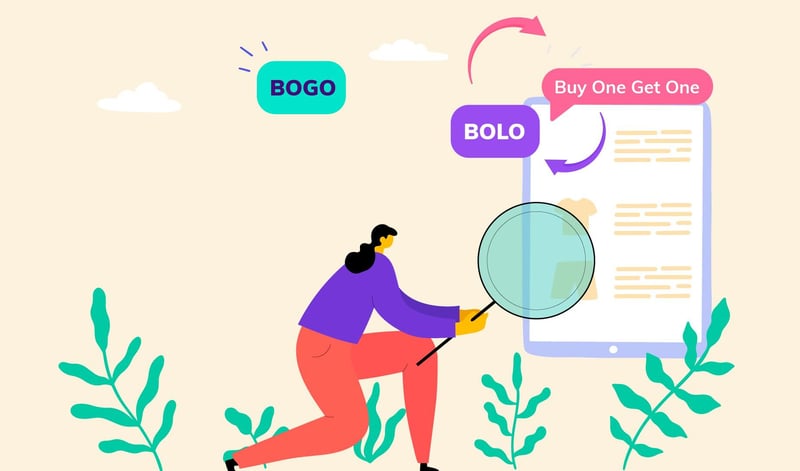There are many unique terms and phrases in the reseller community. Here is a reseller glossary for all of the common acronyms, terms, and phrases!
💡Bookmark this page for future reference.
General Reselling Terms & Acronyms
Here is a dictionary for common reseller terms and phrases:
ASP: Average sale price
“Bins”: the Goodwill outlets where items are sold by the pound, usually in large receptacles (“bins”)
BETA: BETA is the second letter in the Greek alphabet, and it is an abbreviation for the concept of “BETA testing.” A BETA test is a trial of a feature or software in the final stages of development. When something is in BETA, it is still in testing and not fully complete.
BOGO: Buy One Get One (Free). This is a phrase used when sellers host a sale.
BOLO: “Be on the lookout.” For example, BOLO brands are trending brands for resale.
Bundle: Where a buyer purchases more than one item at the same time to be shipped together.
BIN: Buy It Now. An eBay selling mode where instant purchase is available (as opposed to auction-style listings)
CCO: Poshmark Closet Clearout (see below)
COA: Certificate of authenticity.
COG: Cost of goods. The amount a seller spends on a stock item for resale.
Comps: “Comparables” referring to comparable pricing for similar items, reviewed to assist in pricing items for resale.
💡 Conditions are commonly used in titles to note the condition without using too many characters.
NWT: New with tags
BNWT: Brand new with tags
NIB: New in box
NIP: New in package
NWOT: New without tags
EUC: Excellent used condition
GUC: Good used condition
Preloved: Usually refers to a used item with flaws or obvious signs of wear. It is a polite way to say “heavily worn”
HTF: Hard to find, rare
ISO: In search of
INAD: “Item Not as Described”, the name of the formal dispute initiated by an eBay buyer to claim the item they received was not as described in the listing. grounds for a purchase dispute on eBay. See below.
Liker: a “liker” is someone who has “liked” your item for sale by clicking on the button to add it to their likes. This works similarly to the way it does on social media.
LTD: Limited Edition.
MDD: Make a Deal Days on Poshmark. See below.
MSRP: Manufacturer’s suggested retail price.
OBO: Or best offer, to denote that a price is not firm, but the seller is open to offers.
OOAK- One of a kind, rare, or unique.
ORP: Original retail price.
OS: One Size.
OSFA: One size fits all.
PFF: Posh Friend Forever, Poshmark’s pun on the popular acronym “BFF”.
OTL: Offers to likers. See below.
OTW: Offers to watchers. See below.
PM/DM: Private message/ direct message.
RA: Retail Arbitrage. Purchasing items brand new from retail or department stores on clearance to sell for a profit. Sometimes, you see “ORA” which is online retail arbitrage.
ROI: Return on investment. This is usually calculated by:
sale price - marketplace fees - shipping fees - and any other expenses = profit.
SEO: Search engine optimization.
SFPF: Smoke-Free/Pet-Free (Not recommended, as there is confusion surrounding if the “F” stands for “free” or “friendly.”
STR: Sell-through rate. Calculated as the total amount of inventory sold during a certain time measured as a percentage of the amount of items listed in the same period.
TOS: Terms of service. Rules and explanations of the details by which a service provider agrees to provide a service and the user agrees to the required rules and terms.
TTS: True to size.
Watcher: a “watcher” is sort of like a liker on eBay. Watchers have viewed your item and clicked “watch” so they can keep track of the item and be notified of price drops and offers.
VA: Virtual assistant.

Enterprise Selling E-Commerce Terms & Acronyms
Here are some more higher-level business terms and acronyms for sellers:
1PL: First-Party Logistics. 1PL is an e-commerce handling model where the business is responsible for its own logistics processes from sourcing to shipping. 2PL, 3PL, 4PL, and so on refer to models where certain parts of the business are handled by other parties. This is common with shipping, warehouse storage, fulfillment, etc.
AOV: Average Order Value. As opposed to ASP (average sale price), orders often include multiple items, so this emphasizes the value of the entire order.
API: Application Programming Interface. APIs are digital communications protocols that allow for simple data requests and data transfers between systems. For example, eBay and Etsy both have APIs.
B2B: Business to Business. B2B e-commerce is the sale of products from one business to another. For example, the brand Ralph Lauren is sold to the company Macy’s to then sell in their department stores (B2B) but is also sold at Ralph Lauren stores directly to customers (B2C).
B2C: Business to Consumer. B2C e-commerce is the sale of products from the business directly to the consumer. For example, the brand Ralph Lauren is sold to the company Macy’s to then sell in their department stores (B2B) but is also sold at Ralph Lauren stores directly to customers (B2C).
CAC: Customer Acquisition Cost. It is calculated as a sum of all expenses incurred in acquiring customers.
CPC: Cost Per Click. This is a digital marketing metric that calculates the cost associated with a customer clicking on a particular marketing ad or link compared to the sales conversions that result from the clicks.
CTA: Call to Action. Statements in a product listing, on a website, or in an advertisement that encourage customers to do something specific.
Unlock Explosive Growth: Sign Up for Vendoo and Start Crosslisting Today!
CTR: Click Through Rate. The ratio of customer clicks to impressions on a given link in an advertisement or marketing material.
FBM: Fulfillment by Merchant. This refers to orders being stored, fulfilled, and shipped by the business as opposed to a third party.
OOS: Out of Stock
PO: Purchase Order
POS: Point of Sale. It is commonly used to describe a “POS” system in (online and) brick-and-mortar stores, where merchants fulfill orders electronically to invoice or charge users. These systems keep inventory regulated to prevent oversale.
PPC: Pay-Per-Click. Pay-per-click is a digital marketing model where sellers are charged based on the number of times an advertisement is clicked. On the contrary, PPS (Pay-per-sale) is when sellers are charged only as a result of actual sales that occur as a result of clicks on the marketing material.
SaaS: Software as a Service. A software tool or platform that is licensed and accessed online. For example, Vendoo is Saas for e-commerce sellers.
SKU: Stock-Keeping Unit. An alphanumeric code used as a unique identifier for products in a seller’s inventory. Make sure to use our SKU generator tool and if want to know more, check out our blog on: What is a Seller SKU?
UPC: Universal Product Code. An alphanumeric code or barcode often used on packaging to make it easy to both scan and identify a product.
For exploring and generating more options, Acronym Generator can offer unique variations that you may not think of on your own.
Poshmark & eBay Acronyms Explained
Here is a little more explanation of some of the marketplace-specific acronyms:
What does CCO stand for on Poshmark?
CCO stands for “Closet Clearout Days.” CCO is a promotional day on Poshmark where sellers can reduce their price by at least 10% (of the lowest historical price) and buyers will be notified of the special deal with a shipping discount. Poshmark pays for the shipping discount on these promotional days, making them a great day to make sales.
What does MDD stand for on Poshmark?
MDD stands for “Make a Deal Days”. MDD is a promotional day on Poshmark where sellers will be entered to win cash prizes for every sale they make as a result of sending OTL (offers to likers) on Poshmark.
What does OTL stand for on Poshmark?
OTL stands for offers to likers. Most sales on Poshmark happen because sellers send offers to people who have liked their items.
OTL is also used on Mercari, Depop, Etsy, Grailed, and many other marketplaces.
What does INAD stand for on eBay?
INAD stands for “Item Not as Described,” and it is a claim that must be formally filed by a buyer on eBay to dispute their purchase and request a refund. Having “INADs” filed negatively impacts your seller score and account.
What does BIN stand for on eBay?
BIN stands for “buy it now.” This means the eBay listing is available for immediate purchase, as opposed to offer-only or auction-style listings.
What does OTW stand for on eBay?
OTW stands for offers to watchers. A “watcher” on eBay is comparable to a “liker” on other marketplaces. eBay watchers have opted to “watch” your item, making it easily accessible for them to find again. They’re often hoping to be notified of offers and price drops. When a seller does “Daily OTW” they are sending offers to watchers daily on eBay.
Did we miss any common reseller acronyms? Share with us below 👇🏽
Ready to start crosslisting? Sign up for Vendoo for FREE today!






